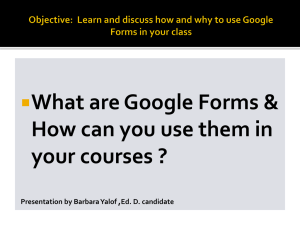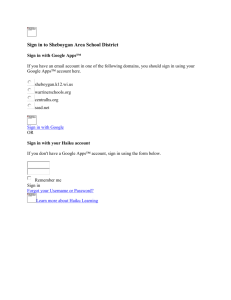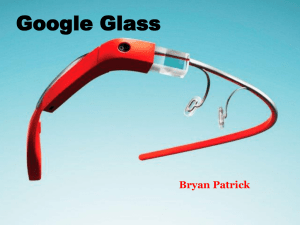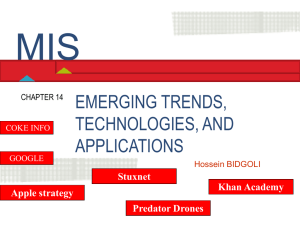Weekly QUEST Discussion Topics and News Mar
advertisement
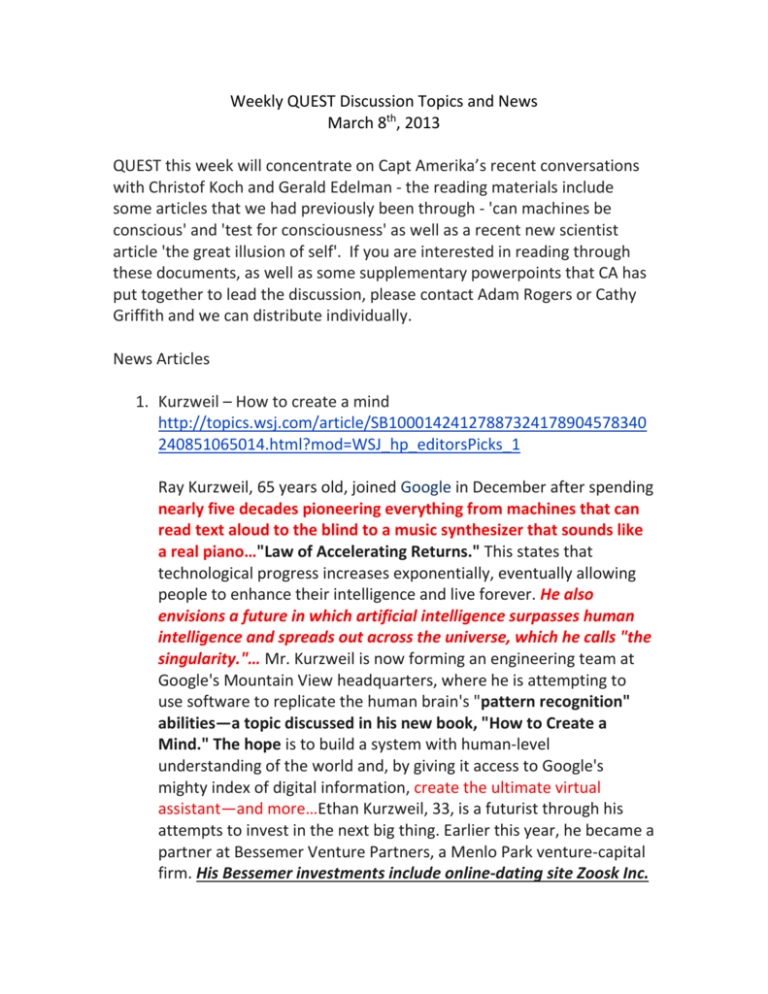
Weekly QUEST Discussion Topics and News March 8th, 2013 QUEST this week will concentrate on Capt Amerika’s recent conversations with Christof Koch and Gerald Edelman - the reading materials include some articles that we had previously been through - 'can machines be conscious' and 'test for consciousness' as well as a recent new scientist article 'the great illusion of self'. If you are interested in reading through these documents, as well as some supplementary powerpoints that CA has put together to lead the discussion, please contact Adam Rogers or Cathy Griffith and we can distribute individually. News Articles 1. Kurzweil – How to create a mind http://topics.wsj.com/article/SB10001424127887324178904578340 240851065014.html?mod=WSJ_hp_editorsPicks_1 Ray Kurzweil, 65 years old, joined Google in December after spending nearly five decades pioneering everything from machines that can read text aloud to the blind to a music synthesizer that sounds like a real piano…"Law of Accelerating Returns." This states that technological progress increases exponentially, eventually allowing people to enhance their intelligence and live forever. He also envisions a future in which artificial intelligence surpasses human intelligence and spreads out across the universe, which he calls "the singularity."… Mr. Kurzweil is now forming an engineering team at Google's Mountain View headquarters, where he is attempting to use software to replicate the human brain's "pattern recognition" abilities—a topic discussed in his new book, "How to Create a Mind." The hope is to build a system with human-level understanding of the world and, by giving it access to Google's mighty index of digital information, create the ultimate virtual assistant—and more…Ethan Kurzweil, 33, is a futurist through his attempts to invest in the next big thing. Earlier this year, he became a partner at Bessemer Venture Partners, a Menlo Park venture-capital firm. His Bessemer investments include online-dating site Zoosk Inc. and CrowdFlower Inc., which helps companies quickly find workers to perform tasks online… WSJ: What are the top technological achievements of the past five years? Ray Kurzweil: The concept of biotechnology has become real. Five years ago, there were no examples of success. Now, if you damage your heart in a heart attack, you can fix that with stem-cell therapies. You can get a trachea replaced with something grown in a petri dish. It's treating the body as software… WSJ: Do you really believe you can design software that matches the complexity of human interaction? Ray: We're at the threshold where computers can understand natural language, human language. That's equivalent to doing anything interactive. There have been text interactions where people didn't know they were talking to a computer. Some people might say, "Oh, that's so limited." Watson beat the "Jeopardy!" [game show] champions, and that's not a narrow game. It has riddles. If a computer has access to Google scale information, it can get real knowledge and…can enhance answers to search queries. We're not trying to create human-level performance right away… WSJ: What will happen technologically in the next five years? Ray: My message is the law of accelerating returns and how remarkably predictable the exponential growth of IT is. More and more things become IT, like health and medicine. There will be 3-D printing, augmented reality. Ethan: Every step along the way will freak people out. Ray: With nanodevices that will be implanted in our bodies to repair us, putting technology in our bloodstream, lots of people will opt out at first. 2. EEG for determining consciousness http://www.technologyreview.com/news/511891/researchersidentify-states-of-unconsciousness-with-eeg-data/ Anesthesiologists have limited ways of tracking what’s happening in the unconscious brain…Researchers have identified patterns of brain activity that correlate to the loss and recovery of consciousness while a patient undergoes general anesthesia. Their findings, reported yesterday in the Proceedings of the National Academy of Sciences online, could one day help anesthesiologists better monitor consciousness in their patients.. Some hospitals and researchers use electroencephalographic (EEG) monitoring, which measures electrical activity in the brain’s cortex through electrodes on the scalp, but this data is typically simplified into a single number or index to assess a patient’s level of consciousness. “The real thorn in the side of the indices is they suppose the people are unconscious at the same indices, that it applies for all people across all drugs, and that just cannot be”… The team recorded EEG patterns in 10 healthy volunteers while giving them increasing and then decreasing levels of a widely used anesthetic called propofol. The participants listened to verbal cues such as their name and auditory clicks and were told to press a button in response to each, which the researchers used as a sign of loss or recovery of consciousness…team found unique patterns in the brain waves of the volunteers as they lost and then regained consciousness. Changes in the relationship between brain waves of different frequencies predicted the transitions into and out of consciousness. The team also identified a pattern in the participants’ brain waves that was associated with the deepest state of unconsciousness. The patterns, or “signatures,” could one day be used to monitor and control sedation and unconsciousness in patients given propofol…real beauty of the study is the promise of being able to differentiate between normal drug-induced and injuryinduced sleep…Clear EEG signatures for each state could help guide anesthesiologists, although the timing of the analysis would have to be very fast for it to be useful during procedures…“The current depth of anesthesia monitoring happens with one to two channels of EEG placed over the frontal brain, not because that area is the most important as far as consciousness is concerned, but because it is an easy place to stick to the head,”… 3. Quantum and cyber http://www.foxnews.com/tech/2013/03/04/defeating-cyber-attackswith-quantum-cryptography/#ixzz2Mmrrvkl5 Uninterrupted electricity protects the nation's infrastructure and its computing and communication networks from malicious cyber attacks and accidental failures. But In today’s world of cyber-warfare -- phishing scams, logic bombs, Trojan horses, viruses and worms -threats to the American power grid abound…To maintain control, data must be transmitted rapidly, securely and seamlessly between control centers. And traditional cryptographic techniques struggle to meet the need for speed and security…Using quantum cryptography, Los Alamos National Laboratory has developed a method to detect and defeat an adversary intent on intercepting or attacking power grid communications. New technologies like this system are critical to protecting critical national infrastructure…traditional cryptology, information is encoded and decoded with mathematics; in quantum cryptology, physics protects data instead, using photons to transmit a key…single photons are used to produce secure random numbers between users. Once the photon key is transmitted, then coding and encoding can take place. Because the random numbers are produced securely, they act as a cryptographic key to authenticate and encrypt the power grid data and commands…team has also invented a novel miniaturized quantum cryptography transmitter. Called the QKarD, it is about five times smaller than traditional devices. The Los Alamos team is seeking funding to develop an even smaller QKarD using integrated electro-photonics methods… 4. How does Google work http://www.foxnews.com/tech/2013/03/05/google-reveals-how-itssearch-results-work/#ixzz2Mmr3cECm results you see are a product of complex machinations, and for the first time, Google is giving people a behind-the-scenes look at how search works…Google has launched a new site, "How Search Works," featuring a clever infographic that not only reveals the process of search, but gives a real-time view of spam removal — a key component that shows the pages users don't see are just as important as those they do when it comes to good results…numbers tell the story. Google "crawls" and tracks trillions of Web pages, ranking each page's importance based on more than 200 algorithms or formulas. Since its start in 1997, Google has accumulated about 100 million gigabytes of information…Google has fielded 450 billion first-time searches and many more that are duplicates of those.. Google's methods have already eliminated a lot of the garbage on the Web. Every day, millions of worthless pages are created, which Google lumps together as spam. Spam sites have long tried to trick Google into thinking they're legitimate, using methods like cloaking (displaying different content to human users than is shown to search engines)… Google has automated formulas to find these pages and has a team that reviews questionable pages as well. On its new site, you can see pages that Google has removed in the last 30 minutes or so… 5. Singularity http://www.time.com/time/magazine/article/0,9171,2048299,00.h tml?artId=2048299?contType=article?chn=sciHealth Creating a work of art is one of those activities we reserve for humans and humans only. It's an act of self-expression; you're not supposed to be able to do it if you don't have a self. To see creativity, the exclusive domain of humans, usurped by a computer built by a 17-year-old is to watch a line blur that cannot be unblurred, the line between organic intelligence and artificial intelligence…But now, 46 years later, Kurzweil believes that we're approaching a moment when computers will become intelligent, and not just intelligent but more intelligent than humans. When that happens, humanity — our bodies, our minds, our civilization — will be completely and irreversibly transformed. He believes that this moment is not only inevitable but imminent. According to his calculations, the end of human civilization as we know it is about 35 years away…Computers are getting faster. Everybody knows that. Also, computers are getting faster faster — that is, the rate at which they're getting faster is increasing…So if computers are getting so much faster, so incredibly fast, there might conceivably come a moment when they are capable of something comparable to human intelligence. Artificial intelligence. All that horsepower could be put in the service of emulating whatever it is our brains are doing when they create consciousness — not just doing arithmetic very quickly or composing piano music but also driving cars, writing books, making ethical decisions, appreciating fancy paintings, making witty observations at cocktail parties. If you can swallow that idea, and Kurzweil and a lot of other very smart people can, then all bets are off. From that point on, there's no reason to think computers would stop getting more powerful. They would keep on developing until they were far more intelligent than we are. Their rate of development would also continue to increase, because they would take over their own development from their slower-thinking human creators. Imagine a computer scientist that was itself a super-intelligent computer. It would work incredibly quickly. It could draw on huge amounts of data effortlessly. It wouldn't even take breaks to play Farmville…The one thing all these theories have in common is the transformation of our species into something that is no longer recognizable as such to humanity circa 2011. This transformation has a name: the Singularity… 6. Drones in the US http://news.cnet.com/8301-13578_3-57572207-38/dhs-builtdomestic-surveillance-tech-into-predator-drones/ U.S. Department of Homeland Security has customized its Predator drones, originally built for overseas military operations, to carry out at-home surveillance tasks that have civil libertarians worried: identifying civilians carrying guns and tracking their cell phones, government documents show…documents provide more details about the surveillance capabilities of the department's unmanned Predator B drones, which are primarily used to patrol the United States' northern and southern borders but have been pressed into service on behalf of a growing number of law enforcement agencies including the FBI, the Secret Service, the Texas Rangers, and local police…Electronic Privacy Information Center obtained a partially redacted copy of Homeland Security's requirements for its drone fleet through the Freedom of Information Act and published it this week. CNET unearthed an unredacted copy of the requirements that provides additional information about the aircraft's surveillance capabilities…Concern about domestic use of drones is growing, with federal legislation introduced last month that would establish legal safeguards, in addition toparallel efforts underway from state and local lawmakers. The Federal Aviation Administrationrecently said that it will "address privacy-related data collection" by drones…f the Predator drones were used only to identify smugglers or illegal immigrants crossing the Mexican and Canadian borders, or for disaster relief, they might not be especially controversial. But their use domestically by other government agencies has become routine enough -- and expensive enough -- that Homeland Security's inspector general said (PDF) last year that CBP needs to sign agreements "for reimbursement of expenses incurred fulfilling mission requests."… 7. Google glasses http://www.cnn.com/2013/02/25/tech/innovation/google-glassprivacy-andrew-keen/?hpt=hp_c3 Google potentially struck a new blow against privacy when it posted a video preview of its new "Glass" technology -- high-tech spectacles featuring a revolutionary digital interface that enable its wearers to not only view the world through Google's eyes but also automatically photograph all that they see…EU is concerned about the way in which Google has, since last March, been pooling the data of its individual users across its popular services like search, Gmail, Google+ and YouTube in order to bundle them up for advertisers…anxiety over this aggregation of our personal information is twofold. Firstly, Google has done little, if anything, to inform users of this unilateral change. Secondly, Google hasn't offered users a way of opting out. Google insists its privacy policies respect European laws and simply help enhance user experiences. But in the eyes of the EU, those of us using products like YouTube, Gmail or Google+ are being, to borrow a Microsoft coined neologism, "Scroogled" by Google's new privacy policy... Google Glass opens an entirely new front in the digital war against privacy. These spectacles, which have been specifically designed to record everything we see, represent a developmental leap in the history of data that is comparable to moving from the bicycle to the automobile…Apple is supposedly working on its hotly-anticipated wristwatch and wearable personal data devices from companies like Nike and Fitbit are already beginning to revolutionize the healthcare industry… 8. Nature of intelligence http://www.technologyreview.com/view/511881/toothbrushesbristlebots-and-the-nature-ofintelligence/?utm_campaign=newsletters&utm_source=newsletterdaily-all&utm_medium=email&utm_content=20130301 Luca Giomi and pals at Harvard University in Cambridge provide a hint that the answer could be much simpler and significantly stranger even than that. They say complex collective behaviour emerges from the mechanics of moving through an environment. In other words, no special communication, social rules or group intelligence is required….These guys make their discovery using BristleBots, simple automatons made from a toothbrush head and a cellphone vibrator motor. Put a few of these into a circular enclosure and they wander around at random… increased the number of BristleBots, they began to self-organise into things like swirling swarms. The transition from disorder to order is triggered only when the density reaches some threshold…significantly more to this situation than the random motion of dumb automatons. The BristleBots are able to detect and react to aspects of their environment in the sense that they change direction when they bounce off the confining walls and off each other…It is this factor–the ability to interact with the environment and other BristleBots in the simplest manner–that leads to the selforganised behaviour…idea that the interaction between moving objects and their environment can lead to intelligent-like behaviour is by no means new. One interesting example is a seemingly intelligent blob of oil that is able to navigate its way through a maze…not hard to imagine the Bristlebots demonstrating more intelligent-like behaviour by interacting together in more complex environments…interesting question is whether there are any rules that govern the kinds of collective behaviours that emerge; whether emerging behaviour can be engineered in a reproducible way…




